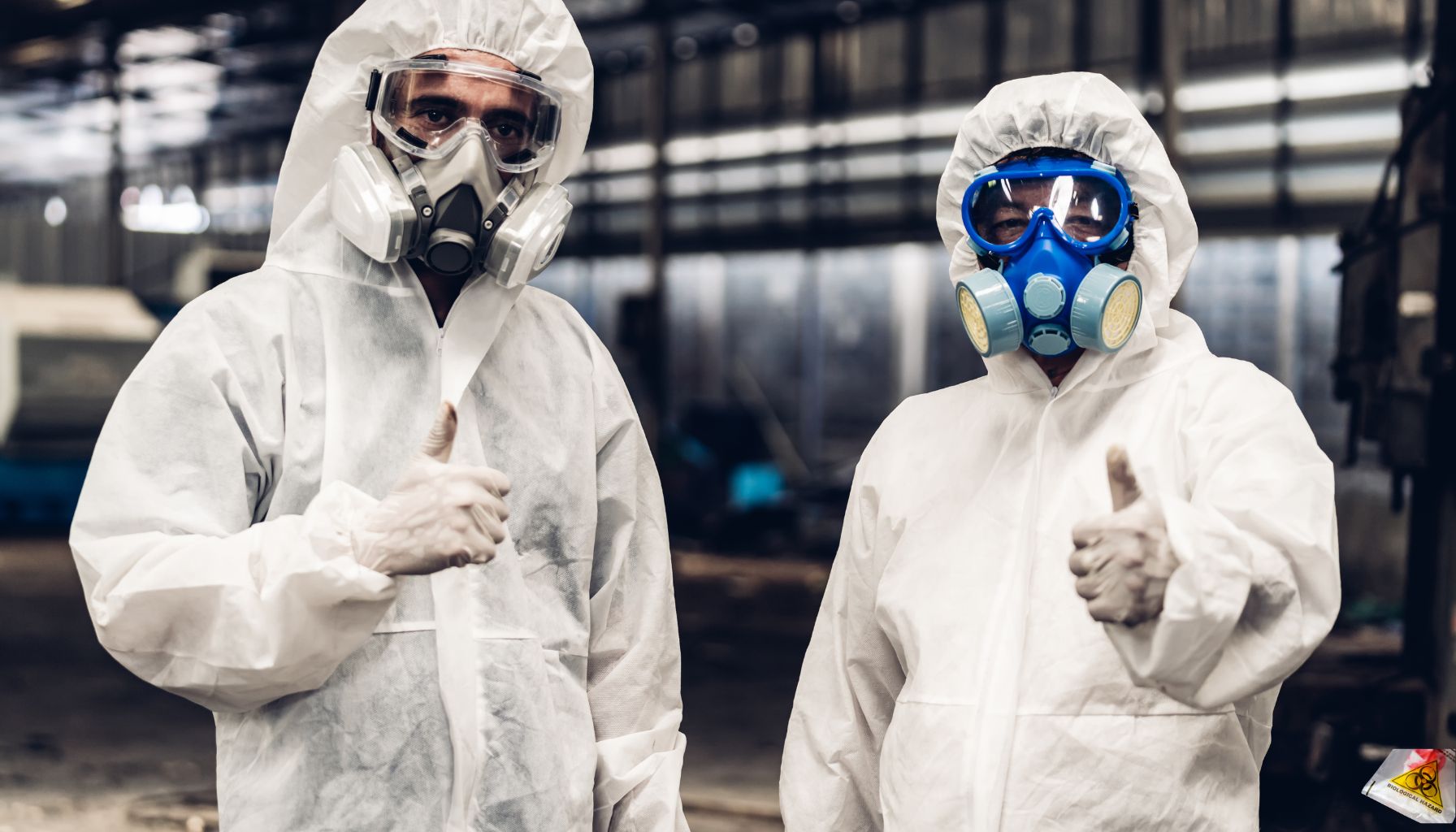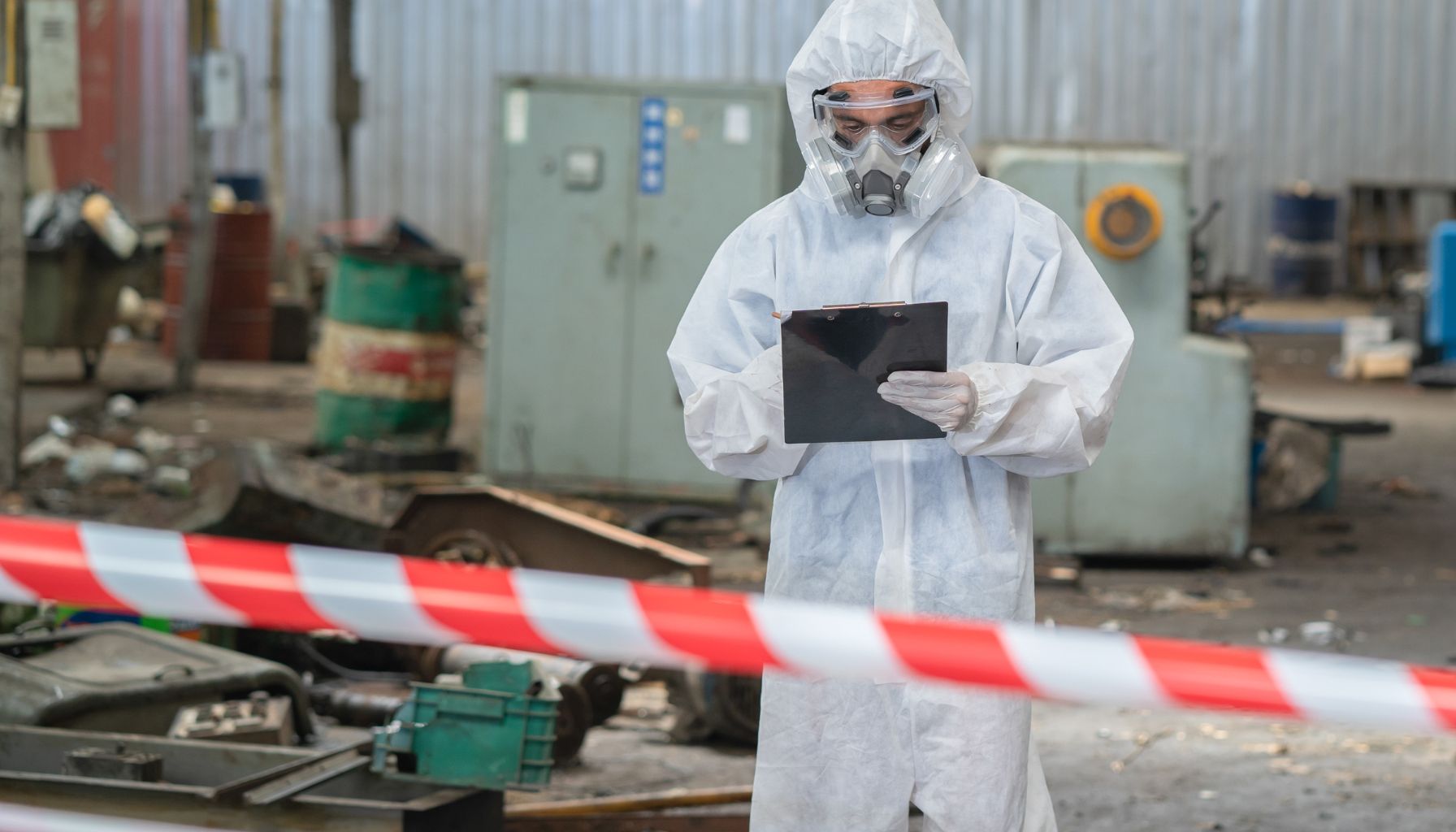From crime scenes to hazardous waste spills…
Biohazard cleanup may not always be a topic that comes up in everyday conversation, but it is a crucial process to ensure the health and safety of individuals and the environment. From crime scenes to hazardous waste spills, biohazard cleanup specialists are trained to handle and remove dangerous materials. In this article, we will explore the process of biohazard cleanup, uncovering the steps involved and shedding light on the importance of this vital service. Additionally, we will also touch upon the cost associated with biohazard cleanup, providing valuable insights for those in need of professional assistance. So, sit back, relax, and let’s embark on a journey of understanding the intricacies of biohazard cleanup together.

The Importance of Biohazard Cleanup
Biohazard cleanup is a critical process that plays a vital role in maintaining public health and safety. It involves the careful and proper removal, containment, and disposal of hazardous materials that pose a risk to individuals and the environment. By understanding the importance of biohazard cleanup, we can take proactive measures to prevent the spread of disease, protect the environment, and ensure the safety of our communities.
Preventing the Spread of Disease
One of the primary reasons why biohazard cleanup is essential is to prevent the spread of disease. Biohazards, which include biological materials such as blood, bodily fluids, and other potentially infectious substances, can harbor harmful pathogens and viruses. Failure to properly clean up and disinfect these materials can lead to the transmission of diseases, such as HIV, hepatitis, and various respiratory infections.
By implementing proper biohazard cleanup procedures, we can effectively eliminate the risk of disease transmission. This not only helps protect individuals who may come into contact with the contaminated area but also prevents the spread of infectious diseases within communities, hospitals, and other public spaces.
Protecting the Environment
Biohazard cleanup also plays a crucial role in protecting the environment. Improper disposal of biohazardous waste can have severe consequences, including the contamination of soil, water, and air. These contaminants can infiltrate ecosystems, harm wildlife, and potentially find their way into our drinking water sources.
By adhering to strict biohazard cleanup protocols, we can ensure that hazardous materials are properly contained and disposed of. This not only mitigates the risk of environmental pollution but also preserves the natural resources that sustain life on our planet.
Ensuring Public Safety
Another significant aspect of biohazard cleanup is ensuring public safety. When biohazardous materials are present, whether in residential, commercial, or public areas, they pose a significant risk to the health and well-being of individuals who come into contact with them. It is essential to address and eliminate these hazards promptly and thoroughly to protect the safety of everyone involved.
Effective biohazard cleanup involves more than just removing visible contaminants. It requires a comprehensive approach that includes proper assessment, planning, containment, decontamination, and disposal of hazardous materials. By entrusting this responsibility to professionals who specialize in biohazard cleanup, we can ensure that every step is conducted with precision and thoroughness, thereby guaranteeing the highest level of public safety.
Understanding Biohazards
Before delving into the biohazard cleanup process, it is crucial to have a clear understanding of what biohazards are, the potential health risks they pose, and the common sources from which they can originate.
Definition and Types of Biohazards
Biohazards, as the name suggests, refer to biological substances or materials that have the potential to cause harm to living organisms. They can include blood, bodily fluids, human and animal tissue, microorganisms, and other types of biological agents.
There are four primary classifications of biohazards:
- Biological Agents: These include bacteria, viruses, fungi, and other microorganisms that can cause infectious diseases.
- Sharps and Contaminated Waste: This category includes needles, broken glass, and other sharp objects that can cause injury, as well as waste materials contaminated with biohazards.
- Human and Animal Tissues: Organs, body parts, and carcasses of animals or humans fall into this category, as they can potentially carry dangerous pathogens.
- Chemical Hazards: Although not exclusively biological, certain chemicals, such as certain cleaning agents or drugs, can have hazardous effects on health and necessitate proper cleanup.
Potential Health Risks
Biohazards pose significant health risks to anyone who comes into contact with them. The exposure to biohazardous materials can lead to various infectious diseases, skin and respiratory infections, and even long-term health complications. It is crucial to handle biohazards with caution and follow proper cleanup procedures to minimize the risk of exposure.
Common Sources of Biohazards
Biohazards can be found in various environments and situations. Some common sources include hospitals and medical facilities, crime scenes, animal facilities, laboratories, and even our own homes. Accidents, natural disasters, and other unexpected events can create situations where biohazardous materials are present. Identifying these sources and promptly addressing them through professional biohazard cleanup is essential to protect ourselves and those around us.
Biohazard Cleanup Process
The biohazard cleanup process consists of several crucial steps that are necessary to ensure safe and effective remediation of contaminated areas. These steps include assessment and planning, the use of personal protective equipment (PPE), containment and isolation, decontamination, and proper disposal of biohazardous waste.
Assessment and Planning
The first step in the biohazard cleanup process is to assess the extent of the contamination and develop a comprehensive plan. This involves identifying the type and severity of the biohazard, evaluating the affected areas, and determining the appropriate cleanup procedures. A thorough assessment and planning stage are essential to ensure that every aspect of the cleanup process is conducted efficiently and safely.
Personal Protective Equipment (PPE)
When it comes to biohazard cleanup, personal protective equipment (PPE) is an absolute necessity. PPE includes items such as gloves, masks, goggles, coveralls, and shoe covers. These protective gear help to minimize the risk of exposure to biohazardous materials, providing a barrier between the individual and potential contaminants. Wearing the proper PPE is crucial for the safety and well-being of those involved in the cleanup process.
Containment and Isolation
Containment and isolation are essential steps in biohazard cleanup to prevent the spread of contamination. This involves setting up physical barriers, such as plastic sheeting or tape, to isolate the affected area from the rest of the environment. Additionally, air filtration devices may be used to ensure that airborne contaminants are contained within the area. Proper containment and isolation not only protect the individuals conducting the cleanup but also prevent cross-contamination to other areas.

Decontamination
Decontamination is a critical step in the biohazard cleanup process, as it involves the thorough cleaning and disinfection of all affected surfaces. Specialized cleaning agents and techniques are used to eliminate the presence of harmful pathogens and ensure that the area is safe for use. Decontamination may involve the use of disinfectants, detergents, and other sanitizing agents to effectively remove any traces of biohazardous materials.
Disposal of Biohazardous Waste
The final step in the biohazard cleanup process is the proper disposal of biohazardous waste. This includes all materials that have come into contact with biohazards, such as contaminated clothing, gloves, cleaning materials, and other related items. Strict regulations govern the disposal of biohazardous waste, and it must be handled and transported in accordance with these guidelines. Failure to adhere to proper disposal practices can lead to environmental contamination, health hazards, and legal consequences.
Professional Biohazard Cleanup Services
Due to the complex and potentially dangerous nature of biohazard cleanup, it is highly recommended to seek the assistance of professional cleanup services. These experts possess the necessary certification, training, equipment, and knowledge to effectively and safely handle biohazardous situations.
Certification and Training
Professional biohazard cleanup technicians undergo specialized training to develop the skills and knowledge required to handle biohazardous materials. They are trained in proper cleanup techniques, safety protocols, and the use of personal protective equipment. Certification from recognized organizations ensures that the cleanup professionals are well-equipped to handle any biohazard situation.
Proper Equipment and Tools
Professional biohazard cleanup services have access to advanced equipment and tools specifically designed for the remediation of biohazardous materials. This includes specialized cleaning agents, industrial-grade decontamination tools, and machinery for proper waste disposal. Utilizing the right equipment and tools ensures that cleanup is done thoroughly and efficiently, minimizing risks to both the cleanup technicians and the environment.
Industry Standards and Regulations
Professional biohazard cleanup services are well-versed in industry standards and regulations. They stay up-to-date with the latest guidelines and requirements set forth by relevant authorities. Strict compliance with these standards guarantees that cleanup is conducted in the most effective, safe, and environmentally responsible manner possible.

Steps to Take in DIY Biohazard Cleanup
While professional biohazard cleanup services are recommended for ensuring safe and thorough cleanup, there may be situations where immediate action is required, and professional assistance is not readily available. In such cases, it is essential to follow certain steps to minimize potential risks.
Assess the Situation
Before attempting any biohazard cleanup on your own, carefully assess the situation. Determine the nature and extent of the biohazard, as well as the risks involved. Keep in mind that certain types of biohazards may require professional intervention due to the complexity and potential health hazards.
Gather the Necessary Supplies
Equip yourself with the necessary supplies for safe biohazard cleanup. This includes personal protective equipment (PPE), such as gloves, masks, goggles, and disposable coveralls. Additionally, gather cleaning agents, disinfectants, plastic bags or containers for waste disposal, and any other tools or materials needed for the cleanup.
Follow Safety Guidelines
It is crucial to adhere to safety guidelines throughout the DIY biohazard cleanup process. This includes wearing the appropriate PPE at all times, following proper cleaning and decontamination procedures, and taking steps to minimize the spread of contaminants. Pay close attention to any warnings or instructions provided by health authorities or government agencies related to biohazard cleanup.
Proper Clean-up and Disinfection Techniques
When conducting DIY biohazard cleanup, it is important to use proper clean-up and disinfection techniques. Follow instructions provided by reputable sources, such as healthcare organizations or government agencies, to ensure that the cleaning and disinfection procedures are done effectively and thoroughly. Take care to avoid any cross-contamination during the process.
Biohazard Cleanup Cost Factors
The cost of biohazard cleanup can vary depending on several factors. Understanding the cost factors can help individuals and organizations better understand and plan for the expenses associated with biohazard cleanup.
Size and Severity of the Biohazard
The size and severity of the biohazard are key cost factors. Larger areas or more extensive contamination will require more time, resources, and labor to clean up. The complexity of the situation may also require specialized equipment and additional safety precautions, which can impact the overall cost.
Location and Accessibility
The location of the biohazard can affect the cost of cleanup. Factors such as ease of access, distance from the cleanup service, and existing infrastructure can influence the cost. Remote or hard-to-reach locations may incur additional expenses for transportation and logistics.
Required Equipment and Resources
The type and amount of equipment, tools, and resources needed for biohazard cleanup will impact the overall cost. Specialized equipment, such as air filtration systems or decontamination units, may add to the expenses. Furthermore, the availability and cost of cleaning agents, disinfectants, and other consumable supplies can contribute to the total cost.
Labor and Time Involved
Labor and time are essential cost factors in biohazard cleanup. The complexity and size of the cleanup project will determine the number of personnel required and the duration of the cleanup process. Higher labor costs and longer work hours can increase the overall expenses.

Risks and Dangers of DIY Biohazard Cleanup
While DIY biohazard cleanup may be a necessity in certain situations, it is essential to recognize the potential risks and dangers involved.
Lack of Proper Training and Knowledge
One of the most significant dangers of DIY biohazard cleanup is the lack of proper training and knowledge. Handling biohazardous materials without the necessary expertise can result in contamination, inadequate sterilization, or improper disposal. This can lead to health hazards, cross-contamination, and further spreading of infectious materials.
Exposure to Health Hazards
DIY biohazard cleanup can expose individuals to various health hazards. Contact with bloodborne pathogens, chemicals, or other biohazardous materials can result in serious illness or injury. Without proper training and protective measures, individuals attempting DIY cleanup are at a higher risk of exposure to these hazards.
Improper Disposal Practices
Improper disposal of biohazardous waste can have severe consequences. DIY cleanup may not provide the necessary knowledge or resources to handle and dispose of biohazardous waste correctly. Improper disposal can lead to environmental pollution, health risks, and potential legal consequences.
Legal and Liability Issues
Engaging in DIY biohazard cleanup without proper training and qualifications may result in legal and liability issues. Failure to comply with industry regulations or local laws regarding biohazard cleanup can lead to legal penalties or lawsuits. It is essential to understand the legal implications and ensure compliance with applicable regulations when engaging in such cleanup activities.
Benefits of Hiring a Professional Biohazard Cleanup Service
While DIY biohazard cleanup may seem like a cost-effective solution, there are many benefits to hiring a professional biohazard cleanup service that outweigh the initial expense:
Expertise and Experience
Professional biohazard cleanup services bring expertise and experience to the table. Their specialized training and knowledge of proper cleanup protocols ensure that every step of the process is executed efficiently and effectively. Their experience in handling various biohazard situations equips them with the skills to address different scenarios properly.
Efficient and Safe Cleanup Process
Professional cleanup services are equipped with the necessary tools, equipment, and resources to perform efficient and safe biohazard cleanup. Their experience allows them to work quickly while maintaining strict safety standards. By hiring professionals, you can rest assured that the cleanup process will be carried out promptly and effectively.
Proper Disposal and Legal Compliance
Professional cleanup services are well-versed in the regulations and requirements for the proper disposal of biohazardous waste. They ensure compliance with all relevant laws and guidelines, minimizing the risk of environmental contamination and legal implications. Hiring professionals provides reassurance that all waste will be disposed of in a safe and responsible manner.
Peace of Mind
Perhaps one of the most significant benefits of hiring a professional biohazard cleanup service is the peace of mind it brings. Dealing with biohazardous materials can be emotionally and mentally challenging. By entrusting the cleanup to professionals, you can focus on other important matters, knowing that experts are taking care of the situation.
Biohazard Cleanup Insurance Coverage
Managing the financial aspects of biohazard cleanup can be a concern for many individuals and businesses. Fortunately, there are insurance coverage options available that can help alleviate the financial burden associated with biohazard cleanup.

Homeowner’s Insurance
Some homeowner’s insurance policies offer coverage for biohazard cleanup. However, it is crucial to review the policy in detail to understand the extent of coverage. Basic policies may not include biohazard cleanup, or there may be certain limitations and exclusions. It is advisable to contact the insurance provider directly to discuss coverage options and any specific requirements.
Commercial Property Insurance
Similarly, commercial property insurance may include coverage for biohazard cleanup. Businesses should review their policy to determine the extent of coverage and any specific conditions. It is essential to notify the insurance provider promptly in the event of a biohazardous situation to ensure compliance with policy requirements.
Understanding Coverage Limits
When it comes to insurance coverage for biohazard cleanup, it is essential to understand the limitations and coverage limits outlined in the policy. Certain costs may be covered, such as cleanup services, decontamination, and disposal of biohazardous waste. However, coverage limits may apply, and it is crucial to be aware of these limits to avoid unexpected out-of-pocket expenses.
Filing a Claim
In the event of a biohazard cleanup, it is important to notify the insurance provider and initiate the claims process as soon as possible. Keep detailed records of all expenses, including invoices, receipts, and any documentation related to the cleanup. Cooperation with the insurance provider throughout the claims process will help expedite the resolution and ensure proper reimbursement.
Conclusion
Biohazard cleanup is a critical process that should never be taken lightly. By understanding the importance of biohazard cleanup, the potential health risks involved, and the proper procedures for handling and disposing of hazardous materials, we can protect ourselves, our communities, and the environment. While DIY cleanup may be an option in some cases, it is highly recommended to hire professional biohazard cleanup services for the most efficient, safe, and effective remediation. When faced with a biohazardous situation, remember the significance of proper training, compliance with regulations, and the availability of insurance coverage. By taking biohazard cleanup seriously and arming ourselves with the knowledge and resources necessary, we can help educate and protect ourselves and others in any biohazard situation.
Contact PureOne Services Now
Disclaimer: All PureOne Services locations do not hold all of these listed certifications.



